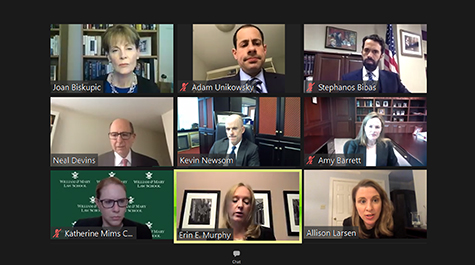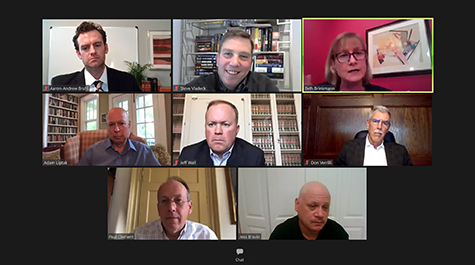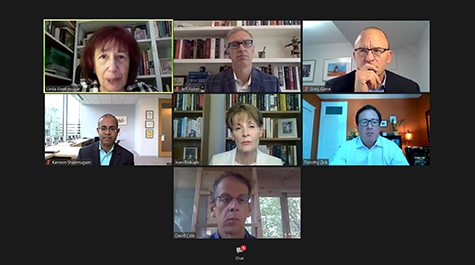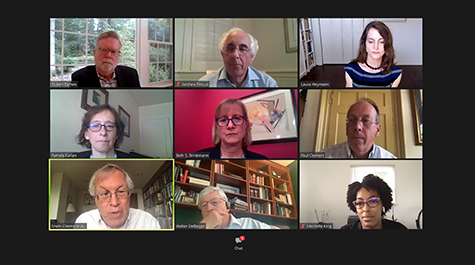William & Mary Law School’s Annual Supreme Court Preview Goes Online for 2020
Editor’s note: The Supreme Court Preview Moot Court is an educational role-playing exercise only and does not necessarily reflect the views of the participants. Every year this important message is conveyed at the beginning of the moot court. This year, Professor Allison Orr Larsen, said: “I want to remind everyone that our goal here is educational and we are role playing. You should not take the questions we ask or the arguments we make as personal endorsements.”
The COVID-19 pandemic may have precluded in-person events at William & Mary Law School for the fall semester, but the 33th annual Supreme Court Preview went ahead as planned on September 11-12, this time online.
Hosted by the Institute of Bill of Rights Law (IBRL), the event was spearheaded by Professor Allison Orr Larsen, who recently succeeded Professor Neal Devins as director of the IBRL.
Larsen thanked Devins for his many years of important work with the Institute and for being “exceedingly kind and generous in guiding us through this unusual first [online] preview.”
A. Benjamin Spencer, William & Mary Law School’s new dean, was also on hand Friday afternoon to offer welcoming remarks.
“There is no better group of people that you can imagine to come together and to discuss these topics,” Spencer said. “This is the best assemblage of advocates jurists and legal scholars that one could possibly put together, and this is the right place to do it at our Law School.”
As always, the Preview officially began with a Moot Court, in which experienced Supreme Court advocates present arguments before a panel of mock Supreme Court Justices. (*Please see editor's note above: Moot Court "is an educational, role-playing exercise only.") This year’s case concerned California v. Texas, which presents another constitutional challenge to the individual mandate in the Affordable Care Act.
Advocates Erin Murphy (Kirkland & Ellis) and Pratik Shah (Akin Gump) argued before Professor Larsen (acting as Chief) and Justices Amy Barrett (U.S. Court of Appeals, 7th Circuit), Kevin Newsom (U.S. Court of Appeals, 11th Circuit), Stephanos Bibas (U.S. Court of Appeals, 3rd Circuit), Adam Unikowsky (Jenner & Block), Neal Devins (W&M Law), Katherine Crocker (W&M Law), and Joan Biskupic (CNN).
The decision came in 5-3 (with one dissent) that there was standing to challenge the individual mandate and a compelling argument that the provision was unconstitutional, but that the whole statute did not fall. The majority reasoned that because the mandate is now set to zero and is not functioning like a tax, it does not fall under one of Congress’s enumerating powers under Article One. Having said that, the court also found it was a severable provision of the ACA, leaving the rest of the law intact.
The Moot Court was followed by a panel discussion on “The Supreme Court and the 2020 Election: What Challenges are likely and what will be the Supreme Court’s Role in Deciding them?”
The panel, moderated by Adam Liptak (New York Times) and Rebecca Green (W&M Law) and consisting of Pamela Karlan (Stanford Law), Paul Smith (Georgetown Law and Campaign Legal Centers), Kannon Shanmugam (Paul | Weiss), Franita Tolson (Univ. of Southern California, Gould School of Law) and Benjamin Ginsberg (Jones Day), discussed trends in COVID-related election cases at the Court so far, anticipated which challenges are likely going forward, and speculated what the Supreme Court’s role will be in deciding them.
The Preview resumed on Saturday afternoon with a panel on “Transparency and the Shadow Docket,” moderated by Jess Bravin (Wall Street Journal) and Aaron-Andrew Bruhl (W&M Law). Panelists Jeffrey Wall (Office of the Solicitor General of the United States), Stephen Vladeck (Univ. of Texas School of Law), Beth Brinkmann (Covington & Burling), Adam Liptak, Paul Clement (Kirkland & Ellis) and Donald Verrilli (Munger, Tolles, & Olson) discussed what is new and what is not about the shadow docket, speculated on the ways in which the Court will use these orders going forward, and commented on the upsides and downsides of doing so.
The second panel asked “Who is the Real John Roberts?” Moderators Joan Biskupic and Timothy Zick (W&M Law) and panelists David Cole (American Civil Liberties Union), Linda Greenhouse (Yale Law), Greg Garre (Latham & Watkins, LLP), Kannon Shanmugam and Jeffrey Fisher (Stanford Law) anticipated which cases will provide an opportunity for the Chief Justice to cast the deciding vote, and addressed whether the Chief Justice’s voting pattern in 2020 was indicative of a shift or should be otherwise explained.
The final panel, moderated by Bob Barnes (Washington Post) and Laura Heymann (W&M Law), asked “What is the Future of the Supreme Court?” Panelists Beth Brinkmann, Andrew Pincus (Mayer Brown), Paul Clement, Pamela Karlan, Erwin Chemerinsky (UC Berkeley School of Law) and Walter Dellinger (O’Melveny & Myers LLP) discussed which structural changes to the Court seem most likely to be adopted and what concerns are motivating them.
The final panel was notable for the participation of William & Mary law students. Mechelle King ’21, Erica Shuler ’22, Daniel Glenn ’22, Evan Baines ’21, Hope Forbush ’21 and Danielle Musselman ’22 joined the panelists online and asked some penetrating questions, mostly regarding the nominating process and diversification of the Court, as well as ways of depoliticizing the Court.
After participating, Erica Shuler referred to the Supreme Court Preview as one of her favorite weekends of the year.
"I was thrilled to listen to experts debate pressing issues, discussing both the current state of the Supreme Court and proposals for reform," Shuler said. "As I asked my own question during the final panel, I became starstruck in realizing that I was addressing some of the sharpest legal minds in our country—together in a single Zoom call. I’m confident that I’ll be reflecting on the rich conversations I heard at the Preview for months to come (at least until the next Preview in September 2021!)."
Larsen rounded off the online event with praise for what she termed an “unusual but successful Supreme Court Preview.” And she looked forward to next year’s event, which she hoped would again be in person.
“Thank you all for coming and showing by example the value of learning from each other and being open to listening to various points of view,” Larsen concluded.
***
Nearly one week after the conclusion of this year’s Supreme Court Preview came news of the passing of U.S. Supreme Court Justice Ruth Bader Ginsburg. The William & Mary Law community remembers her inspiring work and legacy.
About William & Mary Law School
Thomas Jefferson founded William & Mary Law School in 1779 to train leaders for the new nation. Now in its third century, America’s oldest law school continues its historic mission of educating citizen lawyers who are prepared both to lead and to serve.



